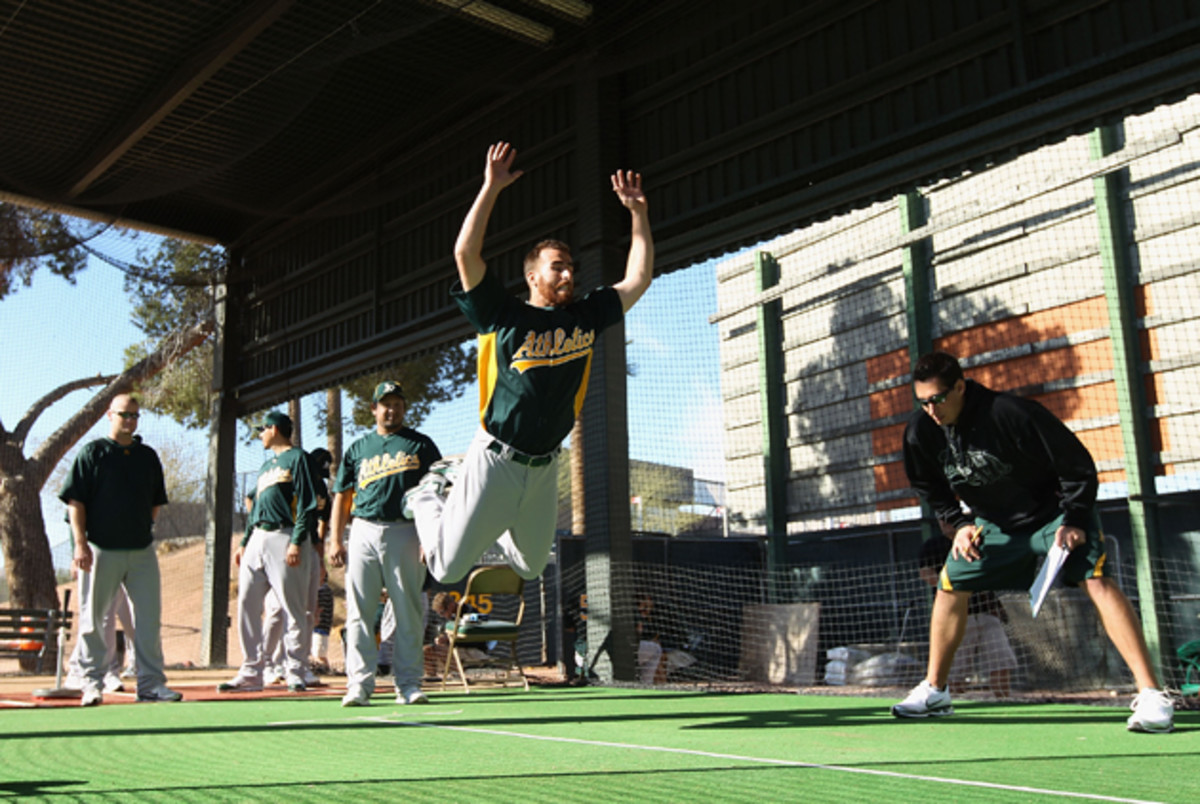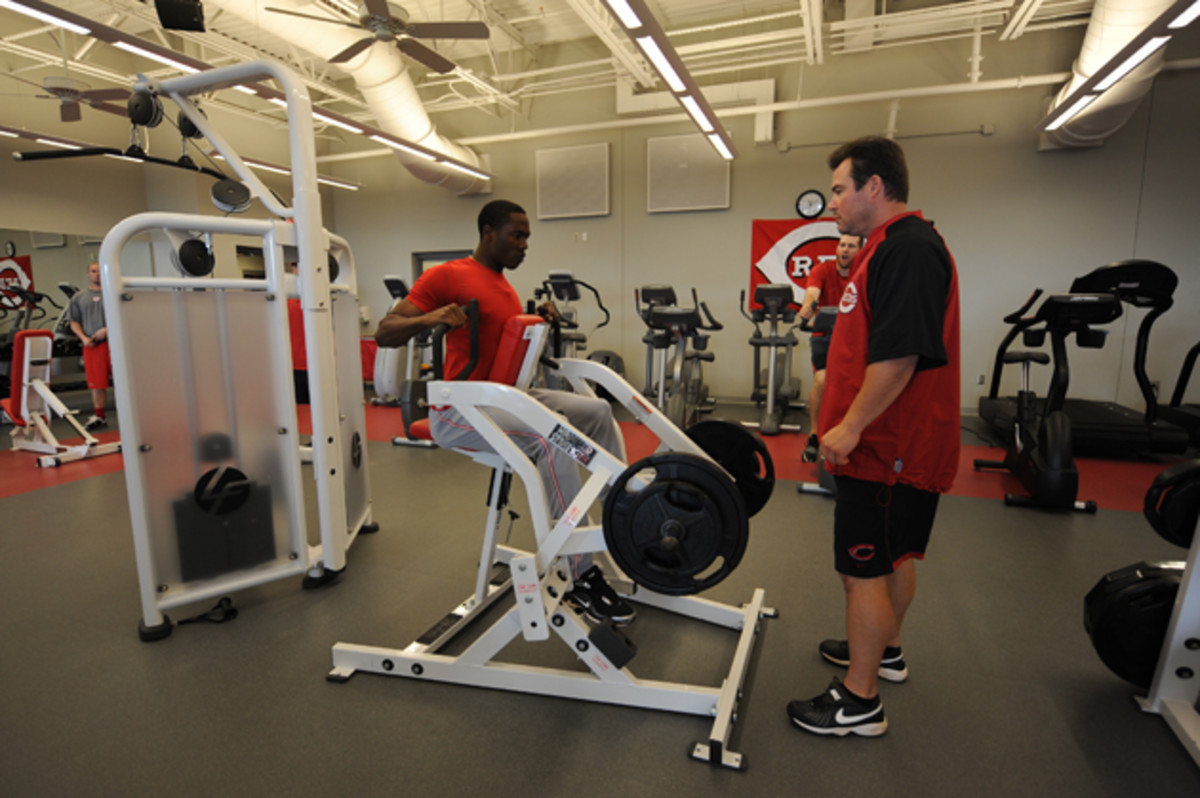The 10 Key Weight Training Exercises for Major League Baseball

Bench press, bicep curls, lat pulldowns—those are just some of the exercises the best players in major league baseball will not be doing this season to remain at the top of their game. Sure, baseball’s elite still spend plenty of time in the weight room this time of year, but they’re not wasting crucial recovery time between games doing traditional weightlifting exercises. Instead, players concentrate on moves that build functional and dynamic strength, not big, bulky muscle, with exercises most amateur athletes have never heard of, things like curtsy lunges and Nordic curls.
“The game happens in three planes of movement and at a fast speed, and that’s what we try to do with weightlifting,” explains Carl Kochan, strength and conditioning coach of the San Francisco Giants, currently No. 3 in the MLB power rankings. “It’s such a ballistic sport and things happen so quickly, and then there’s a long pause between play. So if their movement isn’t efficient—that’s what separates the best players from others.” Here, Kochan and Brendan McDaniel, strength and conditioning coach of the L.A. Dodgers, the No. 12 team in the power rankings, share the 10 weightlifting exercises they say are imperative for any player, regardless of his position.

1. TRX row: Why do a regular row when you can do one off a suspension trainer that forces you to fight for every inch of lateral pull? “This is primarily a back exercise, but because you’re using an unstable device, it activates your glutes and core, and you’re working on posture all at the same time,” says McDaniel. “The stronger we make our backs, the more we slow down the baseball, the deceleration process.” Kochan ups the ante in San Francisco by tasking some of his athletes to do TRX rows while standing on a precarious surface such as Bosu ball, which helps hone proprioception, or balance, to an even greater degree.
2. Lunge matrix: Lots of athletes do lunges, but few can complete a lunge matrix, which mandates players take a deep, quad-burning dive in every direction: front, back, laterally, and back at an angle, otherwise known as a curtsy lunge. “It’s a pretty good bang for your buck in terms of lower-extremity function and movement indicative of sport-specific patterns in baseball,” Kochan says. The Giants strength coach also gives the exercise a high score because he can do it with players anywhere—no equipment necessary. “Some of the weight rooms we have are better than others, but this is an exercise I can reproduce in any field at any time,” he says.
MORE: Throwing Long: The Case For the Long Toss Technique
3. Rear-foot elevated split squat: The next time you’re in the weight room, face the mirror, put one foot behind you on a bench, and lunge forward on the other leg. Not so easy, right? Now do the same thing with your rear foot in a swinging suspension device while you struggle with two dumbbells or a heavy kettlebell. “The nice thing about this exercise is that it can be progressed from a basic lunge—which every guy in our organization can do—all the way to putting your back leg in a TRX while holding dumbbells in your hand,” says McDaniel. The Dodgers strength coach says he especially likes the exercise because it helps to increase range of motion through the hip flexors. “It really opens guys up after long plane flights or training rides,” he says. “It also mimics running mechanics, and there’s a lot of stability that has to be created in order to hold yourself in position.”
4. Traditional step-up: “This is about as close to a sport-specific movement you can get without a bat in your hand,” says Kochan of the traditional step-up, which players do by stepping up with one leg onto a box or bench. But the Giants strength coach mixes it up by making his players do lateral step-ups and a crossover version, in which athletes use one leg to transverse the other and step up onto the box, while adding dumbbells, barbells, or weighted vests to bump up the instability factor. “This gives you extension through your ankle joint, hip joint, and knee joint just like you were hitting,” he says. “And again, you can reproduce the exercise anywhere.”
MORE: Finish Strong: NBA Trainers' Push Late-season Fitness
5. Eccentric Nordic hamstring curls: Although there is no Viking-like show of brawn in this exercise, you’ll need unbelievable hamstring strength in order to do just one Nordic curl. Players kneel on the ground while a buddy holds their feet, and then they lower their chest to the ground as slowly as possible, using their hamstrings in tendon-searing restraint to slow their bodies. “It really mimics the eccentric phase of running, which is where you see a lot of hamstring pulls,” says McDaniel. Why not just use a hamstring machine? “Anytime we can put a player in the position where he has to control his own bodyweight and muscles around it, we do it,” he says. “Put him on a machine and all you’re focusing is on his hamstring.” Another benefit? The exercise needs no equipment to be effective. “When we have limited time, space, or resources on the road, we always try to get the most bang for our buck,” says the L.A. strength coach.

6. One-arm dumbbell chest press: “Guys want to train the front of their bodies all the time because that’s what they see in the mirror,” says Kochan, who satisfies the desire with this exercise, in which players do one-armed chest presses with a dumbbell in one hand. “It really stimulates the asymmetrical nature of the sport,” says the San Francisco strength coach, who increases the challenge by asking his athletes to perform the press on a physio ball or foam roller. “As soon as that dumbbell starts to gravitate toward the floor, the other side of your body—your ribcage, your hip, your glutes—starts firing to stabilize. And that’s exactly what happens when you throw, so there’s really a sport-specific benefit of the exercise,” he says.
7. Planks: Who knew the plank, performed by millions of amateur athletes worldwide, would be so essential to big league ball players? “This is where it all starts,” says McDaniel of the pre-push-up abdominal bridge. “It’s a full-body, closed-chain exercise, and it works the shoulders, core, and trunk. You can even get a little glute activation out of it. It’s just a good exercise to reinforce a lot of things in baseball.” The Dodgers strength coach makes it more difficult for the “21-year-old guys out of college who can hold a front plank for three minutes,” he says, by having them plank on a physio ball or with their feet suspended in a TRX trainer. “No matter what you’re doing, this is a good position to challenge yourself in,” he says.
RELATED: Tips from the Pros: 12 Things Never to Do in a Marathon
8. Hitter’s put: Instead of swinging a bat, try swinging a heavy medicine ball, loading up your back leg and then hurling the ball like a shot put toward a target. The exercise is called a hitter’s put, and the move is key to improving a player’s hitting power. “When you do this before games, you’re training the muscles and the movement pattern you’re going to use on the field that day. That, in itself, is a win-win,” says Kochan. McDaniel says he uses a similar exercise with his pitchers to increase their throw volume in the early season. “As we build up pitch counts, we’ll use the medicine ball to build up some of that volume and stimulus,” says the L.A. strength coach. “But as their pitch count goes up, the amount with the medicine ball will go down.”
9. Single-leg inverted Romanian deadlift: The Nordic curl isn’t the only international-influenced exercise in the Dodgers regimen. This deadlift—performed by holding one foot off the floor behind you while holding a weight in one hand and hinging forward from your hips—works players’ pelvis and hamstring muscles, says McDaniel. “It’s especially good for pitchers because it mimics letting go of the baseball as close to the plate as possible,” he says. According to the Dodgers strength coach, the exercise also stimulates some of the same mechanics used in running. “Guys can get very knee-dominant when running, and this teaches them to drive from the hip,” he says.
10. Anything that challenges the core: We’re not talking about crunches, but core-honing exercises like box steps and rotational medicine-ball twists that force players to fire the tiny muscles in the pelvis, abs, and lower back. “We’re very core based,” says Kochan of the Giants strength program. “Any time we can stabilize the spine, we do, because baseball is an asymmetrical sport.” McDaniel agrees. “Baseball’s about bodyweight, controlling your own bodyweight. We’re trying to keep them from breaking down during season, not trying to build them up.”
